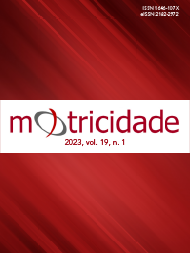Predictive factors of the setting performance and distribution per game complex in junior female volleyball
DOI:
https://doi.org/10.6063/motricidade.27158Keywords:
game analysis, junior female, skills, setting, multinomial logistic regression, correspondence analysisAbstract
The present study aimed to analyse the associations between spatiotemporal characteristics of the setting and the origin of the ball in terms of the game complexes for junior female volleyball teams. Multinomial logistic regression and multiple correspondence analysis were applied to analyse 3.675 setting actions (Complex I = 1.593, Complex II = 2.082) in the final phase of the Greek Junior Championship. Results showed that the origin of the ball from the left lane of the court eases the setter for an accurate setting during CI while passing from the right lane incommodes the setter during CII. Regarding setting zone, for accurate setting, odds are increased by 3.2 for zone 4 during CI while decreased by 23.8 for zone 3 during CII. The junior setters’ distribution of setting is predictable and creates favourable conditions for the opponent to deal with it. The improvement of junior female setters’ ability to follow the team’s offensive tactic regardless of the ball's origin, to manipulate passes received from the right lane of the court during CII and the acceleration of setting tempo for the wing hitters could be training goals for coaches.
Downloads
Published
Issue
Section
License
The authors of submitted manuscripts must transfer the full copyright to Journal Motricidade / Desafio Singular Editions. Granting copyright permission allows the publication and dissemination of the article in printed or electronic formats and copyrights start at the moment the manuscript is accepted for publication. It also allows Journal Motricidade to use and commercialize the article in terms of licensing, lending or selling its content to indexation/abstracts databases and other entities.
According to the terms of the Creative Commons licence, authors may reproduce a reasonable number of copies for personal or professional purpose but without any economic gains. SHERPA/RoMEO allows authors to post a final digital copy (post-printing version) of the article in their websites or on their institutions' scientific repository.


